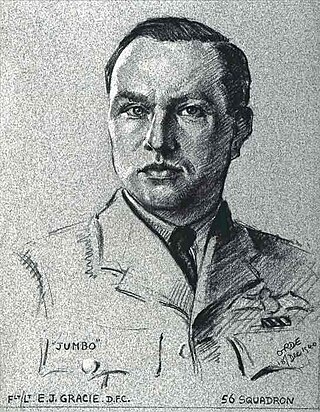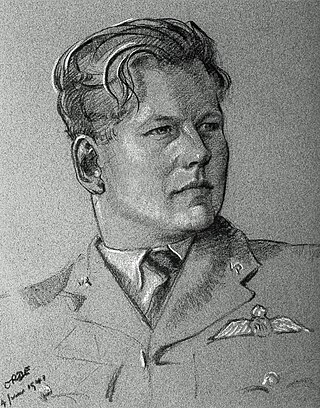
George Frederick "Buzz" Beurling, was the most successful Canadian fighter pilot and flying ace of the Second World War.

James Harry Lacey,, was one of the top scoring Royal Air Force fighter pilots of the Second World War and was the second-highest scoring RAF fighter pilot of the Battle of Britain, behind Pilot Officer Eric Lock of No. 41 Squadron RAF. Lacey was credited with 28 enemy aircraft destroyed, five probables and nine damaged.

Group Captain Colin Falkland Gray, was a Royal Air Force (RAF) officer and the top New Zealand fighter ace of the Second World War.

Raymond Brown Hesselyn, was a New Zealand fighter pilot and flying ace of the Second World War, credited with the destruction of at least 18 enemy aircraft while flying with the Royal Air Force (RAF) over Europe and the Mediterranean.

Group Captain Billy Drake, was a British fighter pilot and air ace. He was credited officially with 18 enemy aircraft destroyed, two shared, two unconfirmed, four probables, two shared probables and five damaged and one shared damaged with the Royal Air Force during the Second World War. Further revisions to these statistics increased this total to 20 destroyed and seven damaged with a further 13 destroyed and four damaged on the ground.

Evan Dall "Rosie" Mackie, was a New Zealand fighter pilot and flying ace of the Second World War. Credited with 21.5 aerial victories, he was the highest scoring flying ace to serve with the Royal New Zealand Air Force (RNZAF).

No. 238 Squadron is a squadron of the Royal Air Force. It was first formed in 1918 by combining number 347, 348 and 349 Flights at RAF Cattewater by the Royal Flying Corps during the First World War. It was reformed for the Second World War, the Berlin Airlift and currently is a Line Training Flight (LTF) squadron based at RAF Cosford, albeit in a non-flying capacity. It is among those officially acknowledged Battle of Britain squadrons.

Anthony Richard Henry Barton was an English flying ace who served with the Royal Air Force (RAF) during the Second World War. He was credited with having shot down at least six aircraft.

Alan McGregor Peart, was a New Zealand fighter pilot and flying ace of the Second World War. He served in Europe with No. 610 Squadron, and with No. 81 Squadron in North Africa, Malta, Sicily, Italy and the Far East. He is credited with the destruction of six enemy aircraft, plus a share in another aircraft destroyed. He is also notable for having shot down aircraft from all three main Axis powers—Germany, Italy and Japan.

John Donald Rae, was a flying ace of the Royal New Zealand Air Force (RNZAF) during the Second World War. He was officially credited with the destruction of twelve enemy aircraft, as well as eight probably destroyed and six damaged.

Gray Stenborg was a New Zealand flying ace of the Royal New Zealand Air Force (RNZAF) during the Second World War. He was credited with 14 confirmed victories, one shared destroyed, and three damaged.

John Arthur Houlton was a New Zealand flying ace of the Royal New Zealand Air Force (RNZAF) during the Second World War. He was credited with the destruction of at least five German aircraft.
William Thomas Edward Rolls was a British flying ace of the Royal Air Force Volunteer Reserve (RAFVR) during the Second World War. He was credited with the destruction of at least 17 aircraft of the Axis powers.

Mervyn Robert Bruce Ingram, was a New Zealand flying ace of the Royal New Zealand Air Force (RNZAF) during the Second World War. He is credited with at least eight aerial victories.

John William Yarra was an Australian flying ace of the Royal Australian Air Force (RAAF) during the Second World War. He was credited with at least twelve aerial victories.

Stanley Franklin Browne, was a New Zealand flying ace of the Royal New Zealand Air Force (RNZAF) during the Second World War. He was officially credited with at least five aerial victories.
Raoul Daddo-Langlois was a British flying ace of the Royal Air Force (RAF) during the Second World War. He was credited with destroying at least five aircraft.
Roderick Illingworth Alpine Smith, was a flying ace who served in the Royal Canadian Air Force (RCAF) during the Second World War. He was credited with having shot down at least fourteen aircraft.

Edward Gracie, was a British flying ace who served with the Royal Air Force (RAF) during the Second World War. He was credited with having shot down at least seven aircraft.

John Bisdee, was a British flying ace who served in the Royal Air Force (RAF) during the Second World War. He was credited with having shot down at least ten aircraft.



















